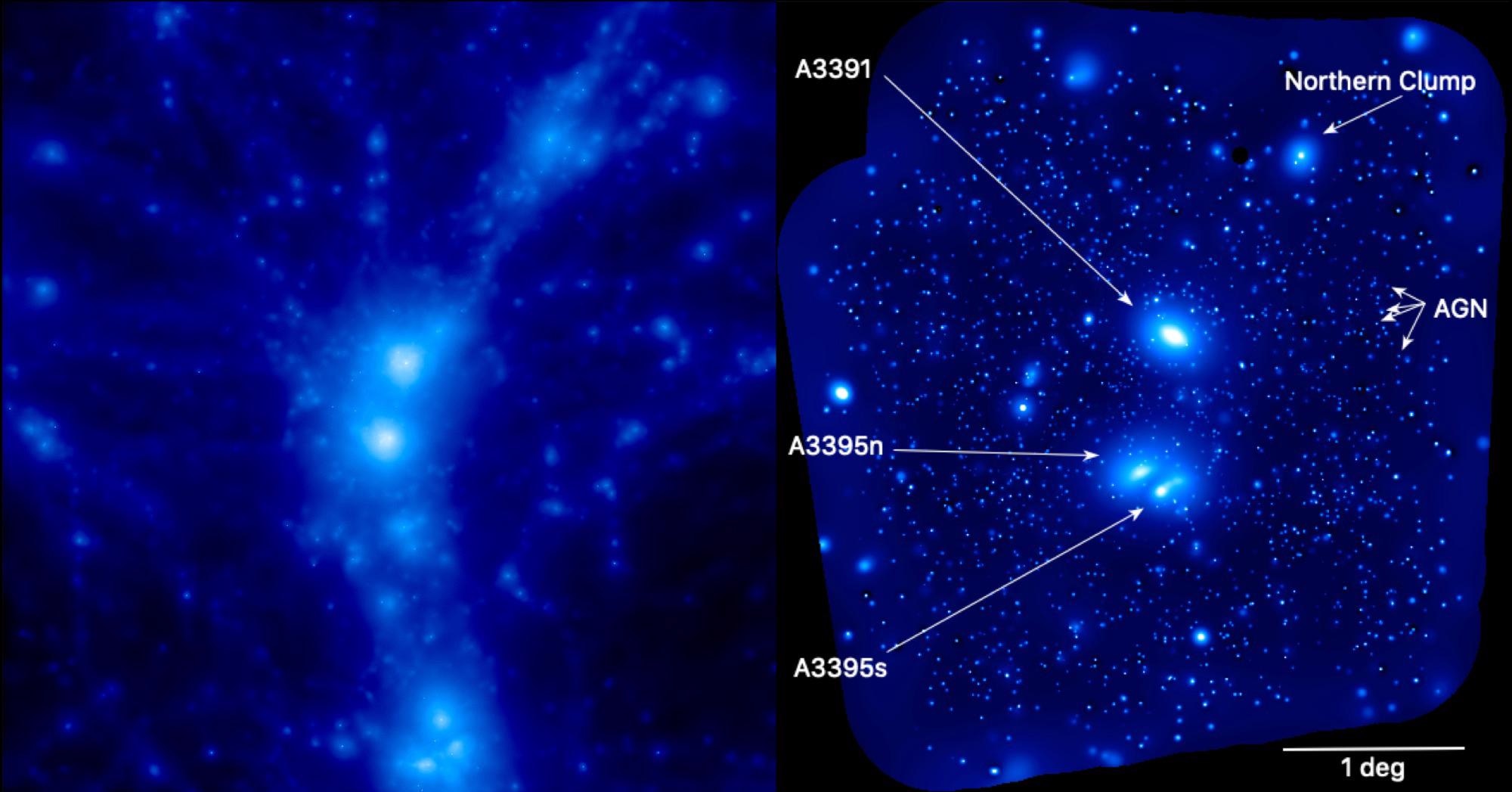Dec 18 2020
To date, over 50% of the matter in the universe has remained invisible to human beings. But astrophysicists had a notion where it might be located: In supposed filaments, incomprehensibly huge thread-like structures of hot gas surrounding and connecting galaxies and clusters of galaxies.
 Still image from a simulation showing the distribution of hot gas (left), compared with the eROSITA X-ray image of the Abell 3391/95 system (right). Image Credit: (c) Reiprich et al., Astronomy & Astrophysics.
Still image from a simulation showing the distribution of hot gas (left), compared with the eROSITA X-ray image of the Abell 3391/95 system (right). Image Credit: (c) Reiprich et al., Astronomy & Astrophysics.
Now, for the first time, a group of researchers, headed by the University of Bonn, has detected a gas filament, whose length stretches to 50 million light-years. The structure of this gas filament is remarkably analogous to the predictions of computer simulations.
Therefore, the observation also validates the concepts relating to the origin and evolution of the universe. The findings of the study have been published in the Astronomy & Astrophysics journal.
Humans owe their existence to a slight irregularity. The Big Bang occurred close to 13.8 billion years ago. It heralded the beginning of time and space and also of all matter that constitutes the universe today. While the Big Bang was originally focused at a single point, it expanded at a tremendous speed—a massive gas cloud, wherein matter was virtually evenly distributed.
Nearly, but not entirely: the cloud in certain parts was slightly denser than in others. It is because of this singular reason that there are galaxies, stars and planets today. The reason for this is that the denser regions applied somewhat higher gravitational forces, which attracted the gas from their vicinities toward them.
As a result, an increasing amount of matter accumulated in these areas over time. But the space between these regions became increasingly emptier. Over the duration of good 13 billion years, a sort of sponge structure emerged—that is, huge 'holes' that lacked matter, with regions in between where an unlimited number of galaxies, the so-called galaxy clusters, are assembled in a tiny space.
Fine Web of Gas Threads
If it actually occurred that way, then the clusters and galaxies must still be linked by the gas remnants, similar to the gossamer-thin threads of a spider web.
According to calculations, more than half of all baryonic matter in our universe is contained in these filaments—this is the form of matter of which stars and planets are composed, as are we ourselves.
Dr Thomas Reiprich, Professor, Argelander Institute for Astronomy, University of Bonn
But to date, it has evaded the human gaze—because of the huge expansion of the filaments, they contain extremely diluted matter. This matter contains only 10 particles per cubic meter, which is relatively less than the best vacuum that can be produced on Earth.
But now with the help of eROSITA space telescope—a novel measuring instrument—Reiprich and his collaborators were able to observe the gas completely for the first time.
eROSITA has very sensitive detectors for the type of X-ray radiation that emanates from the gas in filaments. It also has a large field of view—like a wide-angle lens, it captures a relatively large part of the sky in a single measurement, and at a very high resolution.
Dr Thomas Reiprich, Professor, Argelander Institute for Astronomy, University of Bonn
This enables scientists to take in-depth images of such massive objects, like the filaments, in a relatively short time.
Confirmation of the Standard Model
In their analysis, the investigators analyzed a celestial object known as Abell 3391/95. This system has three galaxy clusters, which is around 700 million light-years away from the Earth.
The images taken with the eROSITA space telescope revealed not only the various individual galaxies and clusters, but also demonstrated the gas filaments that link these structures. The length of the whole filament is 50 million light-years; however, it may be much more massive: According to the researchers, these images only reveal a section.
We compared our observations with the results of a simulation that reconstructs the evolution of the universe. The eROSITA images are strikingly similar to computer-generated graphics. This suggests that the widely accepted standard model for the evolution of the universe is correct.
Dr Thomas Reiprich, Professor, Argelander Institute for Astronomy, University of Bonn
Most significantly, the data demonstrate that the missing matter is likely to be concealed in the filaments.
Reiprich is also a member of the Transdisciplinary Research Area (TRA) “Building blocks of matter and fundamental interactions” at the University of Bonn. In six different TRAs, investigators from the most diverse disciplines and faculties collaborate to work jointly on upcoming-relevant research topics of the University of Excellence.
Participating Institutions and Funding
The study involved nearly 50 investigators from institutions in the United States, Germany, Switzerland, South Africa, Spain, Australia, Japan, and Chile.
The eROSITA space telescope was designed with financial support from the Max Planck Society and the German Aerospace Center (DLR). In 2019, the telescope was launched into space onboard a Russian-German satellite, the construction of which was funded by the Russian space agency Roskosmos.
The study also made use of the Dark Energy Camera (DECam) on the Víctor M. Blanco 4-m Telescope installed at the Cerro Tololo Inter-American Observatory, a Program of NSF’s NOIRLab, and the Australian Square Kilometre Array Pathfinder (ASKAP) telescope, constructed and operated by Commonwealth Scientific and Industrial Research Organisation (CSIRO). The new study was financially supported by many research funding organizations in the participating nations.
Journal Reference:
Reiprich, T. H., et al. (2020) The Abell 3391/95 galaxy cluster system. A 15 Mpc intergalactic medium emission filament, a warm gas bridge, infalling matter clumps, and (re-) accelerated plasma discovered by combining SRG/eROSITA data with ASKAP/EMU and DECam data. Astronomy & Astrophysics. doi.org/10.1051/0004-6361/202039590.